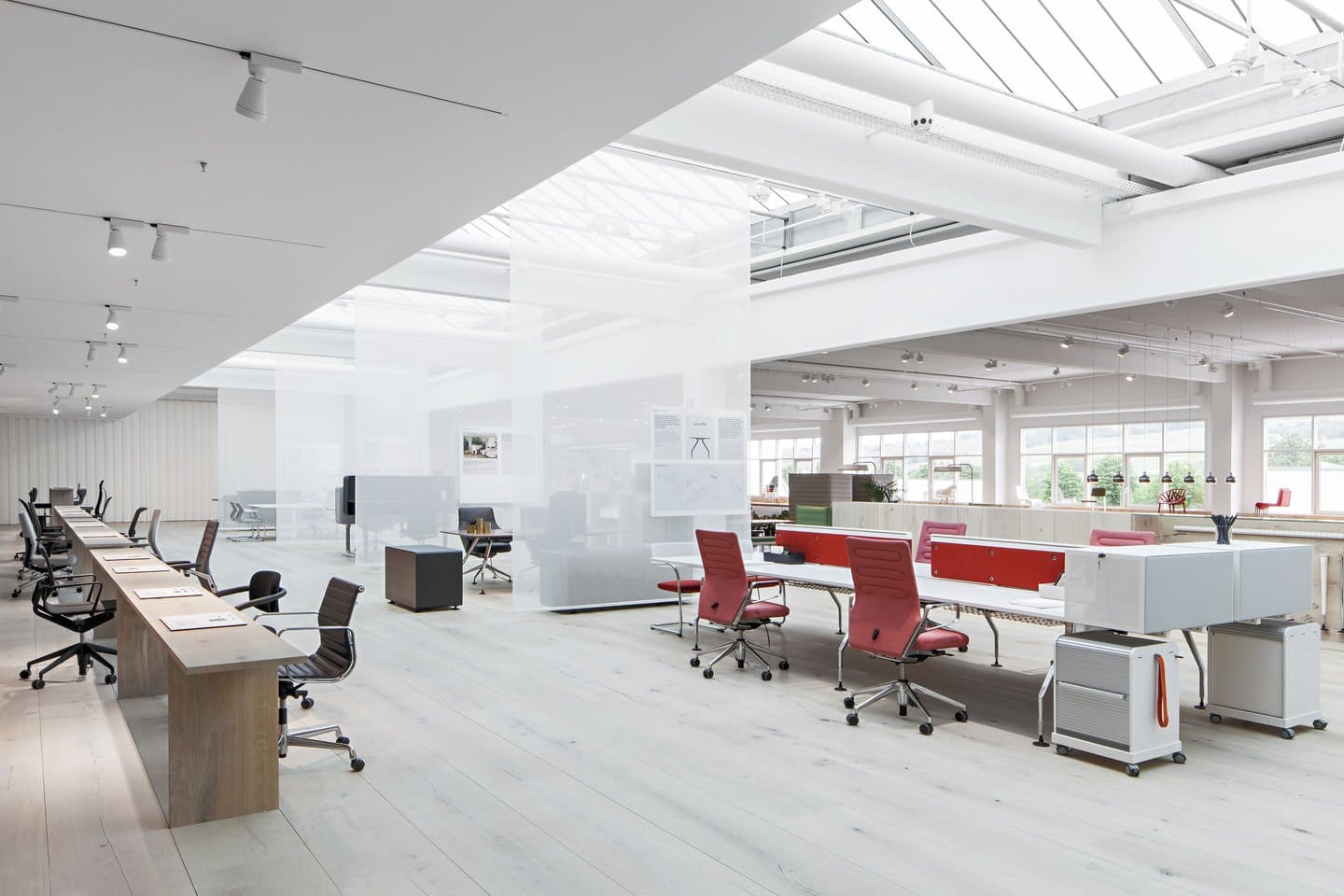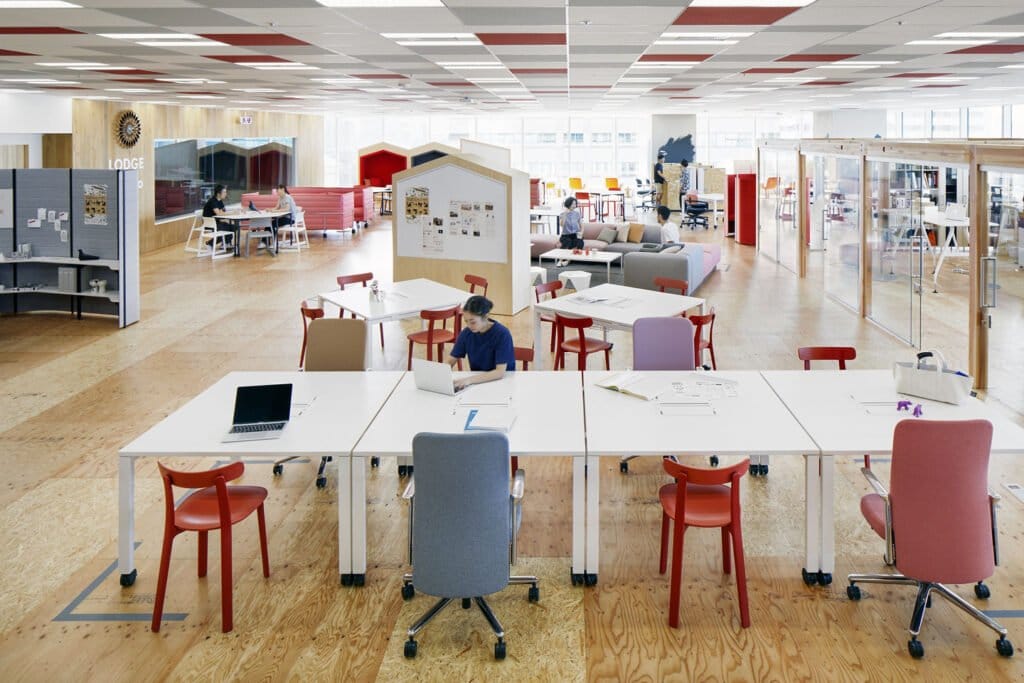
News and views

Flexible work environments are becoming increasingly popular in today’s business world, due to their numerous benefits. Designed to bring people and technology together in an efficient manner, these spaces – where traditional offices are replaced with practical open areas, shared desks and comfortable seating options – encourage creativity, innovation, communication and adaptability, and can also improve work performance.
The workspaces should be conducive to a pleasant atmosphere. After all, it has been proven that the environment has a significant impact on the mood, sense of well-being and motivation of employees. In other words, a positive work environment is usually a productive, happy and safe environment that prioritises cooperation, engagement and equity. Also, it can be an efficient solution for building a strong company culture that promotes high values and success.
As the world continues to evolve, the importance of designing dynamic spaces in all sectors can not be underestimated. First of all, an agile environment hosts different work modes and a wide range of possible activities. For example, with little effort or financial investment, an office can be transformed into a workshop space or a meeting room into a waiting area. This allows visitors or clients to wait in a comfortable and welcoming space while maintaining the professional atmosphere at the office. At the same time, dynamic spaces can be created in any context and are relevant for all sectors: offices and public spaces, educational or health facilities.
Increased productivity
By creating a motivating and dynamic work environment, companies manage to improve the overall well-being and satisfaction of their employees. A workspace with a flexible design, comfortable furniture and a layout that promotes collaboration among team members, can enhance mood and increase organizational performance.
In fact, an agile workspace offers a lot of benefits, revolutionising the way people work, interact and collaborate. First of all, employees have the opportunity to work in a manner that suits their individual preferences. So, they can effortlessly find the best setup for their jobs.
Usually, when employees feel motivated, they are more likely to be focused on their tasks and collaborate effectively with their coworkers, resulting in higher efficiency and productivity, and an increased customer satisfaction.

Cost efficiency
With the ability to easily reconfigure the layout and furniture, companies can maximise their space utilization. In fact, an agile workspace reduces the need for individual offices or cubicles (which can be quite expensive to maintain). In this case, companies can save money by optimising their office spaces and only investing in what is absolutely necessary.
Furthermore, by incorporating flexible furniture and various layout options, an agile workspace can constantly adapt to a company’s changing needs. As the company grows, the workspace can be quickly transformed to accommodate new employees.
A strategy for a better engagement
An agile workspace provides different areas for both individual work and group collaboration. So, in this dynamic and flexible environment, employees can move around, anytime and anywhere, and work in different areas, choosing the most suitable configurations for their needs.
As a result, the engagement of employees will increase in an efficient manner. At the same time, an agile environment promotes a positive work culture that encourages a sense of ownership and autonomy among employees.
Effective team collaboration
In a flexible environment, teams can work together efficiently to achieve common goals. By providing all the necessary resources, an agile workspace facilitates real-time collaboration, creativity and communication.
With open areas and flexible spaces, employees are encouraged to interact constantly and share their ideas. Furthermore, a dynamic workspace provides resources for a better work-life balance, reducing stress and improving mental well-being.
Flexibility
As businesses evolve, so do their workspace requirements. Nowadays, companies must adapt quickly to changes and respond to new opportunities. In such situations, an agile workspace is a perfect solution, providing an excellent flexibility. It allows for easy reconfiguration of the workspace to accommodate changing team sizes, new project requirements, and work styles. The workspace will remain aligned with the needs of the business, fostering agility and responsiveness.
Micro-architectures for an agile workspace

Comma
As we have said before, work environments must be easily adaptable to changing situations. The simplest solution is an open space that can be configured to suit changing needs. Vitra’s answer was to develop the Comma office system.
“Unlike conventional furniture, Comma is an investment in a flexible office environment that can be continually redesigned. It is easy to create structures and reconfigure them in countless ways with just a basic kit of parts – from individual workstations to shelving, from telephone booths to team benches and workshop spaces.” – Christian Grosen, Chief Design Officer, Vitra
The office furniture system Comma is an expression of the dynamic spirit of a new generation of entrepreneurs, who wish to challenge the codes and rules of the 20th century and can not relate to the traditional office layout. Users can apply their full creativity time after time and redesign the office environment best suited to their current requirements, without the need for additional tools. Comma follows the function – and aesthetic – of scaffolding.

Alcove
The “room in a room” is a concept that Vitra has intensively pursued over many years in collaboration with the designers Ronan and Erwan Bouroullec. In 2006, the idea of mobile micro-architectural elements led to the development of the Alcove family, which has been continuously expanded with new models ever since.
Nearly one-and-a-half metres high, the side and back panels of the Alcove Highback Sofa are padded and covered with fabric to offer effective sound absorption, a casual appearance and inviting comfort. With these characteristics, Alcove was perfectly timed for contemporary offices concepts.
Alcove’s product features extend beyond the properties of a simple piece of furniture: with side and back panels in various heights, Alcove units form rooms within a room, creating ideal spaces for concentrated work or for small meetings.

Soft Work
The Soft Work office seating system embodies Vitra’s expertise from the home, office and public sectors. Instead of creating a working environment centred around desks with peripheral sofas, Soft Work has developed into a system in which table workstations are focused around a seating landscape.
“The workstation is going the same way as the dining room – it’s disappearing as an archetype. The desk has had its day. With mobile technology you need a place to sit occasionally, or a comfortable place to hang out. That’s our belief.” – Edward Barber and Jay Osgerby, British designers
Soft Work offers a versatile platform for both individuals and teams. Besides ergonomic seating options, users also find practical table surfaces, power outlets and charging stations. Mobile tables and chairs can be pulled up as needed and put away again, and the addition of panels creates spaces for quiet, concentrated work. Thanks to its modular concept, Soft Work can be easily assembled into diverse arrangements, enabling architects to structure the internal spaces of a building, create specific focal points, or define flexible public areas.

Workbays
With Workbays, Ronan and Erwan Bouroullec have developed a micro-architectural system that redefines the working environment and breaks with the typical rigid planning structure of offices. Yet Workbays not only provide office planners with a simple, multifunctional furniture system. They also offer employees the freedom to seek out the optimal environment for the task at hand.
Thus Workbays create distinct areas where individuals or groups can retreat from the general office environment to carry out specific activities. The units come equipped with everything users need: work surfaces, seating and optional storage and power connections. Workbays respond to the necessity for noise reduction, helping to absorb disruptive sounds in the surround- ing environment. They can spontaneously serve as telephone booths, video conference rooms, reading corners, quiet spots for a coffee break or meeting rooms – without sending participants behind closed doors.
Recommended articles

Embrace the magic of nature! Biophilic design – a friendly path to a sustainable future
It is well known that nature has a positive impact on our well-being and mood. For instance, taking a short walk in nature can help us relax and quickly enhance our overall health, making us happier, less stressed, and more creative. However, we can enjoy the same benefits even in our workspaces. Biophilic design focuses […]

#TheOriginals: Panton Chair – a classic in the history of furniture design
The Panton Chair’s curves have become an iconic sight, even though when Verner Panton first proposed the chair to manufacturers in the 1950s, they all considered it a daring concept and even an impossibility. All but Vitra, who embraced the innovative design and, together with Panton, took up the challenge of bringing it to market. […]
On Instagram
Follow us on Instagram for daily inspiration on amazing spaces and iconic products.
